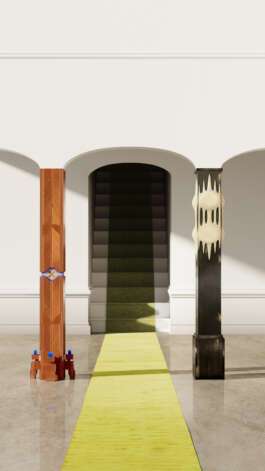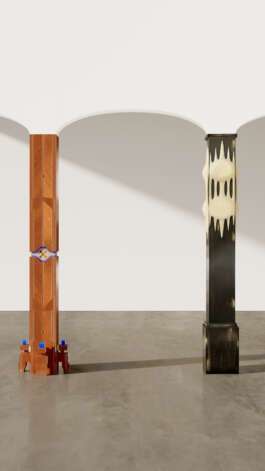



© Sahra Jajarmikhayat
COLLECTIBLE In-Depth
NJ Roseti
August 2024
This series, COLLECTIBLE In-Depth, unveils the backstage of contemporary creation. Tackling various topics from personal designer processes to the position of collectible design on the global design market, COLLECTIBLE In-Depth offers different views to suit all tastes. Today we speak with NJ Roseti.
C: How do you see the relationship between late 20th century design and contemporary design? How does one feed one another?
NJR: The relationship between late 20th-century and contemporary design is an interplay of influence and innovation. Late 20th-century design pushed boundaries, setting the stage for today’s experimental approaches. My work draws from this legacy by combining traditional wood marquetry with contemporary, synthetic forms, creating a dialogue between past and present. This juxtaposition highlights how tradition informs and inspires modernity. At COLLECTIBLE this year, my piece explores this connection, inviting reflection on how past values and aesthetics continue to shape contemporary design. The conversation between old and new remains deeply interconnected, even as mediums evolve.
C: How does the digital sphere impact your work?
NJR: I see no tension between the digital and physical realms; instead, I find the connection between artist and computer beautiful when it enhances creativity. Digital tools offer spontaneity, facilitate iteration, and complement traditional craftsmanship, creating balance. While computers can emulate organic forms, my work focuses on the precision of geometric shapes, highlighting the perfection achievable through digital means. I avoid using AI, as I value the irreplaceable human touch in art. As digital technology grows in collectible design, I aim to balance embracing advancements with preserving traditional craftsmanship.
C: What ethical considerations guide your material choices and sourcing practices in the production of collectible design pieces?
NJR: In my work, I also strive to minimize waste and consider the lifecycle of each piece, creating designs that are not only beautiful but also durable and timeless. By juxtaposing traditional materials like wood with contemporary synthetic elements, I seek to highlight the importance of conscious consumption in both past and present contexts. My goal is to create pieces that respect the natural world while pushing the boundaries of design, fostering a deeper connection between the art, the maker, and the environment.
C: How can collectors contribute to the preservation and promotion of cultural heritage through their acquisitions of collectible design pieces?
NJR: Collectors contribute to the preservation and promotion of cultural heritage by acquiring pieces that reflect traditional craftsmanship and cultural narratives. By investing in works that embody these values, they help sustain artisanal skills and techniques that might otherwise be lost. Additionally, by supporting artists committed to ethical sourcing and sustainability, collectors foster respect for the cultural and environmental contexts of the materials and methods used. Sharing their collections through exhibitions and collaborations further promotes cultural heritage, ensuring that these traditions continue to inspire and influence future generations.

© Peter Favinger

© Peter Favinger

© Sahra Jajarmikhayat
COLLECTIBLE In-Depth
NJ Roseti
August 2024
This series, COLLECTIBLE In-Depth, unveils the backstage of contemporary creation. Tackling various topics from personal designer processes to the position of collectible design on the global design market, COLLECTIBLE In-Depth offers different views to suit all tastes. Today we speak with NJ Roseti.
C: How do you see the relationship between late 20th century design and contemporary design? How does one feed one another?
NJR: The relationship between late 20th-century and contemporary design is an interplay of influence and innovation. Late 20th-century design pushed boundaries, setting the stage for today’s experimental approaches. My work draws from this legacy by combining traditional wood marquetry with contemporary, synthetic forms, creating a dialogue between past and present. This juxtaposition highlights how tradition informs and inspires modernity. At COLLECTIBLE this year, my piece explores this connection, inviting reflection on how past values and aesthetics continue to shape contemporary design. The conversation between old and new remains deeply interconnected, even as mediums evolve.
C: How does the digital sphere impact your work?
NJR: I see no tension between the digital and physical realms; instead, I find the connection between artist and computer beautiful when it enhances creativity. Digital tools offer spontaneity, facilitate iteration, and complement traditional craftsmanship, creating balance. While computers can emulate organic forms, my work focuses on the precision of geometric shapes, highlighting the perfection achievable through digital means. I avoid using AI, as I value the irreplaceable human touch in art. As digital technology grows in collectible design, I aim to balance embracing advancements with preserving traditional craftsmanship.
C: What ethical considerations guide your material choices and sourcing practices in the production of collectible design pieces?
NJR: In my work, I also strive to minimize waste and consider the lifecycle of each piece, creating designs that are not only beautiful but also durable and timeless. By juxtaposing traditional materials like wood with contemporary synthetic elements, I seek to highlight the importance of conscious consumption in both past and present contexts. My goal is to create pieces that respect the natural world while pushing the boundaries of design, fostering a deeper connection between the art, the maker, and the environment.
C: How can collectors contribute to the preservation and promotion of cultural heritage through their acquisitions of collectible design pieces?
NJR: Collectors contribute to the preservation and promotion of cultural heritage by acquiring pieces that reflect traditional craftsmanship and cultural narratives. By investing in works that embody these values, they help sustain artisanal skills and techniques that might otherwise be lost. Additionally, by supporting artists committed to ethical sourcing and sustainability, collectors foster respect for the cultural and environmental contexts of the materials and methods used. Sharing their collections through exhibitions and collaborations further promotes cultural heritage, ensuring that these traditions continue to inspire and influence future generations.

© Peter Favinger

© Peter Favinger
Contact
info@collectible.design
VIP PORTAL
EXHIBITOR PORTAL
PRIVACY POLICY
© 2025 Collectible
Contact
info@collectible.design
VIP PORTAL
EXHIBITOR PORTAL
PRIVACY POLICY
© 2025 Collectible